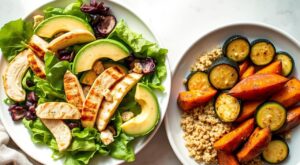Ever thought a simple diet change could boost your family’s energy and health? One family found out how a gluten-free diet meal plan changed their lives. They started using gluten-free recipes that everyone loved, making their meals better and their days more lively.
In this article, you’ll hear their story and how to make a gluten-free diet work for your family. It’s all about improving your family’s energy and health.
What is a Gluten‑Free Diet?
A gluten-free diet means avoiding foods with gluten. Gluten is a protein in wheat, barley, and rye. It’s key for those with gluten intolerance and related disorders. Knowing about gluten helps you make better health choices.
Understanding Gluten and Its Effects
Gluten makes baked goods elastic and strong. But, it’s a problem for those with gluten intolerance. Symptoms include stomach pain, tiredness, and mood swings.
For people with celiac disease or gluten sensitivity, gluten is harmful. It can cause serious health issues.
Who Should Consider a Gluten‑Free Diet?
If gluten makes you feel sick or tired, you might have gluten intolerance. Those with celiac disease need to avoid gluten to protect their intestines. People with allergies should also go gluten-free to stay healthy.
Benefits of Going Gluten-Free
Exploring the benefits of a gluten-free diet shows how it can improve your life. People who follow this diet often feel better in many ways. They notice more energy, better digestion, and a happier mood.
Increased Energy and Vitality
Many people feel more energetic when they avoid gluten. They say they feel lighter and more alive all day. This energy boost makes everyday tasks more fun and less hard.
Improved Digestive Health
Going gluten-free can greatly improve your digestion. It helps those with gluten issues feel better in their stomachs. It can reduce bloating, gas, and other problems. This leads to better nutrient absorption and overall health.
Better Mood and Focus
Switching to gluten-free can also make you feel happier and more focused. You might feel less tired and more patient. This can help you do better at work and in your personal life.

Crafting a Family-Friendly Gluten-Free Diet Meal Plan
Creating a gluten-free meal plan can be fun for your family. It’s filled with tasty options that everyone will enjoy. You can find meal ideas that fit different tastes and needs. This way, every meal is both healthy and delicious.
Breakfast Ideas for All Ages
- Gluten-free smoothies made with spinach, banana, and almond milk
- Overnight oats with gluten-free rolled oats and fresh berries
- Scrambled eggs with sautéed vegetables and gluten-free toast
Lunchtime Options That Everyone Will Love
- Quinoa salad bowls with chopped veggies, black beans, and a lime vinaigrette
- Rice cakes topped with avocado and cherry tomatoes
- Homemade gluten-free wraps filled with turkey, cheese, and spinach
Simple Dinner Recipes for Busy Families
- Zucchini noodles tossed with marinara sauce and grilled chicken
- Stuffed peppers filled with quinoa, ground turkey, and spices
- Oven-baked salmon served with a side of roasted vegetables
Nutrient-Dense Snack Suggestions
- Energy balls made from oats, nut butter, and honey
- Greek yogurt topped with gluten-free granola and fresh fruit
- Vegetable sticks served with hummus for dipping

Essential Ingredients for Your Pantry
Having the right gluten-free pantry staples can change how you cook and eat. With the right ingredients, making tasty meals is easy. Here are the key items to have for gluten-free cooking.
Gluten‑Free Grains and Flours
Gluten-free grains and flours are the base of many recipes. Make sure to include these in your pantry:
- Quinoa
- Brown rice
- Millet
- Almond flour
- Coconut flour
Must-Have Condiments and Spices
Good flavors come from the right condiments and spices. Keep these essentials on hand:
- Gluten-free soy sauce
- Apple cider vinegar
- Olive oil
- Garlic powder
- Black pepper
Fresh Produce and Proteins
Adding fresh produce and proteins to your meals is key. Keep a variety of fruits, veggies, and lean proteins:
- Spinach
- Carrots
- Chicken breast
- Salmon
- Beans
Tips for a Successful Transition
Starting a gluten-free diet can be tough, even for families. It’s key to teach everyone about gluten and its health effects. Knowing why you’re making this change helps your family understand and support you.
Educating Your Family on Gluten Freedom
Start by explaining what gluten is and how it affects health. Talk about the good things that come from a gluten-free diet, like more energy and better digestion. Use fun materials like charts or infographics to teach about gluten.
Reading Labels and Identifying Hidden Gluten
It’s important to check labels for hidden gluten. Many foods, like sauces and snacks, might have gluten without saying so. Teach your family to read labels carefully. Show them how to spot gluten in ingredients like wheat, barley, and rye.
Finding Gluten‑Free Alternatives
Looking for gluten-free options can be fun. There are many choices for your favorite foods. Try using quinoa or rice instead of pasta, and almond or coconut flour in baking. Encourage your family to try new things and find their own gluten-free favorites.

Meal Prep Strategies for Busy Families
It’s tough to keep up with a busy schedule and eat well. Using gluten-free meal prep strategies can make meals easier and healthier. Start by planning your grocery list well to get the right ingredients for your family’s meals.
Creating a Grocery List
A good grocery list is key for meal prep success. Look over recipes you want to try and list all the ingredients. Choose fresh veggies, proteins, and gluten-free grains for family cooking. Use a template or app to make your list easier. For more tips, check out this gluten-free meal prep resource.
Batch Cooking for Quick Meals
Batch cooking saves time and makes weeknight meals easy. Cook big batches of gluten-free lasagna or stuffed sweet potatoes on weekends. Put them in containers for quick meals later. Mix up your recipes to keep things interesting for your family. This way, healthy meals are always ready, making family cooking easier.
Storing and Reheating Leftovers
Storing meals right keeps them fresh. Get good meal prep containers that are airtight and safe for microwaves. Label them with the date so you know how long they’ve been stored. When reheating, make sure they’re hot enough to avoid food sickness. This careful approach makes your gluten-free meal prep both effective and safe.

Delicious Gluten‑Free Recipes
Exploring gluten-free recipes can change how you view healthy meals. It brings fun cooking ideas for the whole family. Here are three great meals that are both nutritious and tasty, making mealtime fun.
Breakfast: Smoothie Bowl Delight
This vibrant smoothie bowl mixes your favorite fruits, greens, and gluten-free granola for crunch. Blend bananas, spinach, and almond milk. Then, top it with berries and nuts. It’s a refreshing breakfast that keeps you energized all morning.
Lunch: Quinoa Salad with Grilled Chicken
This quinoa salad is a healthy, satisfying meal that’s easy to make. Mix cooked quinoa with grilled chicken, fresh veggies, and a light vinaigrette. It’s a burst of flavors that also gives you the nutrients you need for the day.
Dinner: Zucchini Noodles with Pesto and Shrimp
This dish is a tasty twist on traditional pasta. Use zucchini noodles and add shrimp sautéed in homemade pesto. It’s gluten-free and full of flavor, making it a great dinner choice for families looking for healthy meals.
Overcoming Challenges on a Gluten‑Free Diet
Living gluten-free can be tough, like when you’re out with friends or traveling. Knowing how to handle these situations makes life easier. With the right tips, you can enjoy eating out and see the world without worrying about food.
Dining Out and Social Events
Going out to eat gluten-free needs some planning. Look up restaurants that have gluten-free food. Many places now list gluten-free options on their menus.
When you book a table or arrive, tell the staff about your gluten-free diet. They can help you pick safe dishes and might even make changes for you.
- Call ahead or check the restaurant’s website for gluten-free options.
- Ask about cross-contamination procedures to ensure your meal is prepared safely.
- Consider bringing your gluten-free snacks or meal to events where food choices may be limited.
Traveling While Gluten-Free
Traveling gluten-free has its own set of challenges. Before you go, learn about gluten-free food in your destination. Use travel tips like gluten-free food apps or online forums for advice.
Bring gluten-free snacks like bars, nuts, or dried fruit. This way, you won’t go hungry when gluten-free food is hard to find. Look up local grocery stores or markets for safe food shopping. With some planning, your trip can be fun and gluten-free.
| Challenge | Solution |
|---|---|
| Limited gluten-free options at restaurants | Research beforehand and communicate dietary needs clearly. |
| Uncertainty about ingredient safety | Inquire with the staff about meal preparation and cross-contamination. |
| Difficulty finding gluten-free snacks while traveling | Pack convenient snacks and find local grocery stores. |
Success Stories: A Family’s Journey
Switching to a gluten-free diet can change a family’s life for the better. Many families have seen big improvements in their health and energy. They’ve found new foods and made changes that bring them joy and vitality.
Improved Energy Levels and Wellbeing
Family members often feel more energetic after going gluten-free. They notice better focus in kids and adults. This energy boost lets families do more together, like going on outdoor adventures or just hanging out at home.
Embracing New Foods and Habits
Exploring gluten-free foods introduces many nutritious options. Families try new things like quinoa, brown rice, and lots of fruits and veggies. They love trying new recipes and cooking together. This makes them stick to healthier eating.
Feedback from Family Members
Family feedback shows the benefits of gluten-free eating. They enjoy their meals more and like the new tastes and textures. Their stories encourage others to try gluten-free, showing it can greatly improve life quality.












